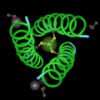Last week, while attending the ISB "DNA of Innovation" symposium in honor of Lee Hood's 70th birthday, I decided to try live-blogging for the first time. Unbeknownst to others in the audience, except my husband, I quietly typed away, collecting notes and uploading impressions.
But battery power has its limits, even when I have more notes to share. And despite all the fascinating speakers, I have notes enough to describe just one more.
The personal genome days have only just begun, but George Church is already looking into the future. In a true "Lee Hood style tour de force" Church talked about the convergence of the 'omes.
He described moving from beyond the idea of a simple human genome to a place where we can combine inherited and environmental genomics.
His vision is a day when our epigenome, microbiome, phenome (our phenotypic traits), and VDJ-ome are all known, along with the resistome, and a public health map of the environment describing all the allergens, microbes, and viruses.
It sounded like we could have almost a mole of hypotheses to test with all the different combinations of interacting 'omes.
How are we going to get there?
He started a project called the "Personal Genomes Project." They have recently gotten IRB approval to enroll 100,000 people.
The project is:
- Open access
- There's a low barrier to participation. You do have to pass a test to show that you understand informed consent, but you don't need a Ph.D. in genetics to do this.
- The data are identified.
- The project is cheaper than normal genome sequencing because they are focusing on certain sequences and not sequencing the whole thing. In particular, they are looking at protein coding sequences and selected regulatory sequences.
All that sounds pretty reasonable, but there's something really exciting that they're doing, too. It's great to have a human genome sequence and all, but we'd really like to have sequences from all the different cell types, too, at many stages of development. Church said it's a bit challenging to get volunteers to agree to contribute samples from all their tissues.
So, what can be done?
Well, the researches take a small piece of skin from their volunteers and make those skin cells into stem cells. Then, they use retroviruses or adenoviruses to make the cells differentiate into tissues.
This whole idea just blows my mind. No need to get multiple tissue samples, just grow your own!
I'm thinking of volunteering. This could be fun!
For more of the conference, see: Happy Birthday Lee, ISB1, ISB2

What can the sequence of different cell types tell us? The genomic info is the same except a few random mutations that will pop up. Or are they looking at the transcriptome of each cell type?
They're looking for two things.
First, there's the transcriptome, which I forgot to list in my list of omes. Different genes are used in different types of cells.
Second, you're wrong about the genomic info being the same. In B and T cells, the DNA is rearranged during development, bringing the V, D, and J regions together to code for antibodies and T cell receptors. The rearranged DNA constitutes the VDJ ome. They're also looking at the transcripts, too.
Ummm, the fee to "volunteer" for the Personal Genome Project appears to be $1000.
http://www.personalgenomes.org/howitworks.html
That's not my idea of a low barrier to participation.
I guess the idea of "low cost" is relative. A price of $1000 for all the work they're proposing to do is amazingly cheap. I doubt they could do this if they weren't going to be heavily subsidized by grant funding.
To get some idea of what it really costs to sequence a human genome, we can do some comparison shopping. In January 2008, Knome was offering to sequence your genome and do all the bioinformatics for $350,000.
Knome doesn't have a price on their web site anymore, but their service would have provided far less information than you would get from the Personal Genomes Project.
Thanks for posting your notes Sandy, I wish I could have seen those presentations. We're living in interesting times, no doubt!
The ISB also has a yearly symposium with many of the presentations available as streaming video. Here's the 2008 link: http://www.systemsbiology.org/Resources_and_Development/ISB_Annual_Symp…